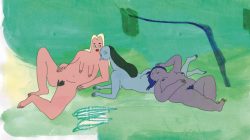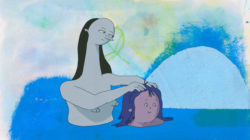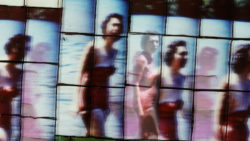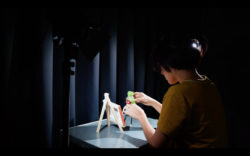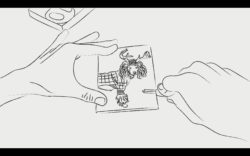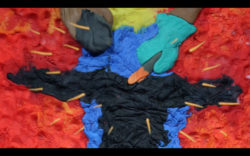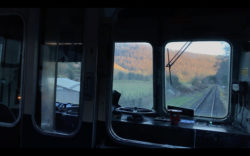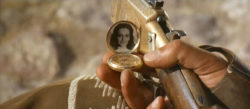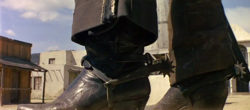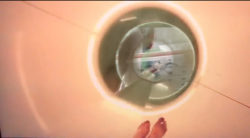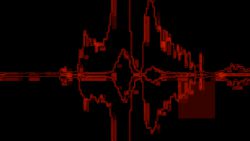New Toronto Works 2020 Interviews by Shahbaz Khayambashi
PD: What does your work have to say about feminine friendship?
The Bathers, Sonia Beckwith: The Bathers represents my idealized version of feminine friendship. The characters perform acts of caring for each other and themselves with no sense of competition or hierarchy between them. Through their interactions, I hoped to convey a deep sense of comfort that you only feel with the closest of friends. For me, it serves as a reminder of how valuable it is to lift each other up and care for one another as women.
PD: What is the connection between images and memory? In a post-photography age, are images a necessity for remembrance?
Little Boshkung (“lake of many echoes”), Andrew Lennox: I look at connections between art and existence. Memory is definitely a part of the impetus and drive behind art-making for me personally but my focus is more toward art-making and mortality – that objects can endure longer than the mind/body and help to express some aspect of the existence of the maker and their world. My practice is centered around object and motion picture works so image-making is part of it but I am mostly interested in analog film as an object because of the connection between objects of art and motion pictures. Moreover, I appreciate its archival qualities and its use as a social document. It is a very useful tool because it contains so much visual information that can be stored and read as an object or as a projection. In a sense, it’s about a collective memory but I think about film more in terms of an artifact, to be read by someone outside of our collective memory. I think that artifacts are often some of the most instructive tools available to understanding a civilization. Often, these items are banal objects like a mug and I view home movies in a similar vein. Yes, I think it’s about memory but for external observation, as opposed to, internal reflection. I don’t really consider myself to belong to one movement or knowledgeable enough on the subject of post-photography to answer this question. I will say that I draw influence from a lot of sources outside of photography that aid my memory or constitute someone else’s memory. Cornell used a lot of objects, images, and writings in his sculptures which have a lot to do with collective and personal memory. I think memories engage with all of our senses because we use those senses to form our experiences.
PD: Why did you choose to create a work about creating a work? In other words, what does art about creating art ultimately say about the creative process?
Aches, Nikole Hidalgo McGregor: There is a joy of discovery that is commonplace in the art scene. Given how technology allows us to better document the artistic process, artists are now able to offer a unified hedonic experience to viewers that goes from an appreciation of the piece to its creation. Creating and documenting art allows viewers a new way to digest art. Aches elevates this into an art form itself as both creation and documentation become a single artistic expression. However, it also challenges people’s understanding of art documentation as these focus on how components are moulded into art while disregarding the artists themselves. Showcasing the creative process tends to ignore the bodily sacrifice that artists make and how their body deteriorates as repetitive motions cause pain and harm.
PD: Your video exists between English and Mandarin, Toronto, and Washington, dealing with Islamophobia and war. With regards to your title, coherence, what are you trying to say about the modern collective state of mind?
Coherence (or maybe not…), Bo Fan: This work is one of my recent experiments of capturing narrative as a casual observer. In the form of a video, indeed, it seems to be concerned with a lot, but at the bottom, it is about desire; desire for pleasure, desire for intellectualization, wanting things to make sense, yearning for coherence (both in my artworks and in my life), yet feeling vulnerable, desperate and self-deprecating at the same time. We are living in a frantic time, a time of xenophobia, a time of taking sides, a time that everyone wants to get involved in everything, yet not knowing anything anymore. What does it mean to be an art practitioner? What do I want? I don’t know and I don’t want to pretend that I know.
PD: What does your work have to say about toxic masculinity?
Here You Can Only Gain Respect by Killing Other Men, Renee Lear: Short answer: nothing. My work is not commenting on or critiquing toxic masculinity. Should toxic masculinity be critiqued? Yes. Is there a reading of this piece that could take this on? Probably. But what I had in mind was an experiment: what happens when you apply this process to this visual material. The “process” is editing different films together, two frames at a time in succession as if making an animation—animating them together to make one coherent piece. The considerations for choosing the material were both formal and aesthetic with a strong notion that the audio would push it in a compelling direction. The result is a motion study with a piecemeal psychedelic soundtrack. The three films animated together become simultaneously slow and fast. Different faces from disparate times and spaces morph together as if they are one in real-time. Long shots and close-ups, dark scenes and light, flicker in a mesmerizing, hallucinatory extended present. The audio chunks and pools together in sublime weirdness. For me, the question is not what does it mean, but what does it do?
PD: Is it possible to make art today without referencing Trump and everything he represents? In other words, has the haunting spectre changed from communism to populist fascism?
Unquiet on the Western Front, Sophie Jaworski: I would hope that it is certainly possible to make art without referencing Trump, and would suggest that it is very important to do so in order to continue to build community and imagine other radical futurities beyond our current time of late-capitalism, pandemic, and climate change. Part of the intention behind ‘Unquiet on the Western Front,’ (a play on the film All Quiet on the Western Front) in particular, however, is to provoke reflection on the reification process itself. By using overdetermined imagery such as peaches to signify impeachment, for instance, I was hoping to create a space where inundation of images—and the almost hypersaturated white-supremacist rhetoric surrounding Trump and the bigotry and violence he represents—can be processed and engaged within a way that destabilizes its power as defacto oppressive and totalizing at least in the space of its encounter. In this way, the non-linear and somewhat chaotic ambience of the film, through its montage, and unsettling thriller-like soundscape, might open up alternatives to a sense of defeatism, or a sensory anesthesia which can be depoliticizing. This is limited as a representation of my own reflections on my positionality as a white settler. Of course, there are multiple forms of intersecting oppression and so this process, and the feelings the film brings up, would feel very different for each viewer. For this reason, I like the frame of haunting you use, because the digital world and the world of liberal media certainly enacts knowledge production non-linguistically, and through affect. This uneven reification of the visual, and how visual media justifies and economizes particular fascist narratives and ideologies is one thing scholars interested in data justice are especially concerned with naming and disrupting. Overall, I am definitely really interested in how digital media art and film can trouble historiocities of imperialism and empire, especially in a North American or Turtle Island context. In this film, I return to the recurring motif of an empty state park, a classic western town its horizon eerily fading. Juxtaposing it with echoes of old advertisements, and the vertigo of the solipsistic journey down a waterslide back and forth in time, I am trying to actively problematize the frontier, or the ‘Western Front’ that is at the heart of much far-right populist fascist entitlement and nationalism. It could be construed as a spectre of populist fascism, but also the slippages between this ideology and where affect preceeds the ideological. Whether this exercise is successful or not is certainly up to the viewer.
PD: Is coding an art form? (Blunt and to the point!)
CRACKERS a brief history of code, Jan Swinburne: I’m not sure it matters whether coding is an art form, just as it doesn’t matter if video is an art form. One can use the medium as a subject itself or as a medium. In the video “CRACKERS: a brief history of code”, one could say that the various encoding imagery and sounds represent language that has been “cracked” or “glitched” by the aesthetic treatment. It is broken into audio and visual components that shift around the word’s meaning and deployment as a skill, a slur (social encoding), and a sound. With the stylistic attributes of Morse code, text, and visualized audio waveforms, an aesthetic form is paired with these various communication structures; hopefully, this allows for a nuanced experience that elicits connections of meaning that might not otherwise be expressed. In many respects, this is our dance with language.
— May 2020
